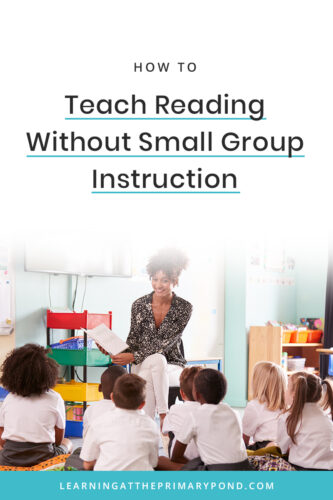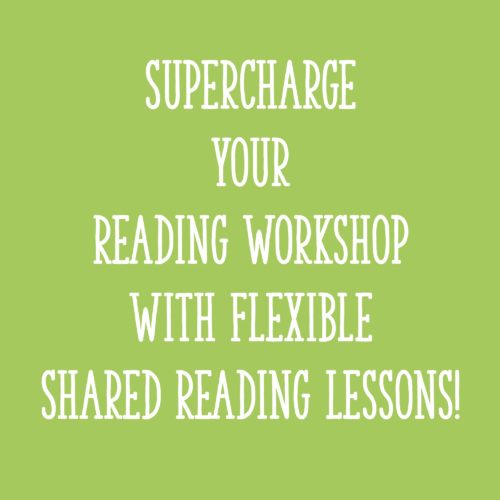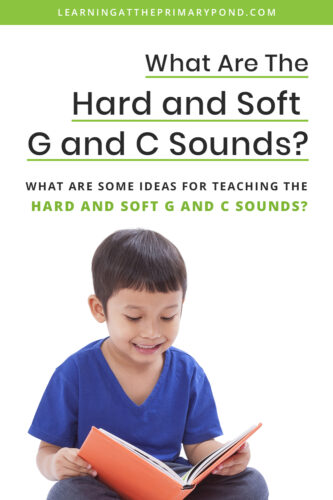I love teaching reading in small groups. In fact, I can’t imagine NOT using small groups to teach reading!
When we work with students in a small group setting, we get to know them as readers. We can better differentiate our instruction. We can give them more personalized attention.
But you know what? I actually have taught reading without using small group instruction.
I student taught in the early days of NCLB (No Child Left Behind) in the U.S.. Basal reading programs were very popular. Each child had a reading textbook, and inside that textbook were 2-3 main texts for each week.
Most basal reading programs do have books and resources for small group instruction. In my case, we did eventually have a Title 1 teacher push in. At that point, I think we used some of the leveled readers for a bit of small group instruction.
I don’t remember all the specifics (it’s been a minute ?), but I do know that we were using primarily whole group instruction to teach reading, at least for a while.
So why do I bring this up?
As I’m writing this, we’re in the midst of the Covid pandemic. Teaching has changed dramatically in many schools.
Some teachers are no longer able to do small group instruction. And that is a BIG challenge when you’ve come to rely on small groups to teach reading!
I’m still a big believer in small group reading instruction. But whole group instruction ISN’T bad! In fact, we can actually do quite a bit of differentiation while teaching in a whole group setting.
So in this blog post, I’m going to share tips for differentiating your whole-group reading instruction.
This post is for you if:
- You’re in a situation where you can’t use small group instruction OR
- You want tips for differentiating your everyday whole group reading instruction!

Set Up Your Schedule Strategically
In a “normal” teaching situation, I like to alternate between whole-group time and independent work time. (The independent work times are when I pull my small groups.)
This whole-group -> small-group pattern automatically creates opportunities for movement. When I wrap up a whole group lesson, students get up and move to their small group / independent work activity.
But if you’re in a situation where you can’t teach in small groups, you may not automatically have those transition times. So when you’re setting up your schedule, make sure to plan for movement breaks, independent work without small groups, and/or other types of transitions.
I’ve found that Kindergarteners need some type of transition or movement break every 5-10 minutes. 1st graders need it every 10 – 15 minutes. Some 2nd graders can make it to 20 minutes by the end of the school year.
If you need some general schedule help, check out the links below (they do include small group instruction time, but it’ll give you something to start with):
Use Different Types & Levels of Questions
When you’re teaching in a whole group setting, it’s important to recognize that not every question you ask is the right difficulty level for ALL students.
That’s totally okay. I like to ask different questions (and even have different teaching points) at different levels.
For example, if we’ve just read a story, I might ask:
- Who are the characters?
- What was the setting?
- How did the characters feel about the setting?
- How would the story be different if it took place in _______?
The first two questions might be challenging for some students. They’ll be easy for other students. The last two questions may be too challenging for some students. But they’ll be just right for other students.
When you plan questions to ask and topics to discuss, make sure you’re addressing the different levels in your classroom. (I always try to do this, regardless of whether I’m also teaching small groups.)
Pair Students Strategically
Frequent “turn and talks” are a great way to keep students engaged during a whole group lesson. In a turn and talk, students have an opportunity to answer questions or share their ideas with a partner.
This practice can be a life-saver when you have to teach in a whole-group setting.
If you only allow students to speak by raising their hand to answer a question, very few students get a turn! With turn and talks, everyone gets a chance to speak multiple times during each lesson.
However, turn and talks can also be very unproductive if students aren’t paired strategically. If an advanced, talkative student is paired with a quiet, lower student, the lower student may not get a chance to speak.
A long time ago, a professor shared this pairing strategy with me:
- Use a vertical list to rank your students by ability (highest students at the top of the list).
- Cut the list in half.
- Match up your two mini-lists.
This helps create partnerships with a manageable ability gap between the two students. For example, your highest student will be working with a mid-level student (rather than your lowest student).
You may need to assign seats in order to pair up students strategically, but that’s okay. You can (and should) rotate partnerships throughout the year so students have opportunities to work with other students, too.
Use Shared Reading
When it comes to teaching reading, shared reading is a powerful tool. To a certain degree, it can make up for a lack of small group instruction.
During shared reading, you can model reading strategies. Students work with grade-level (or slightly above grade-level) text, and they have your support. You “share” the work of reading the text with students.
To learn more about shared reading and how to do it, check out this blog post:
What is Shared Reading, and Why Is It So Important?
Help Students Feel “Seen” as Individuals
Giving each student personal attention can be challenging, especially if you’re teaching in a whole-group setting. Here are some tips to give attention to each student and help everyone feel “seen:”
- Use some kind of random drawing method (i.e. names on craft sticks) to ensure you’re calling on students equally.
- Use students’ names and interests in your sample sentences, modeled writing, math story problems, etc.
- Have a morning meeting where students have an opportunity to share about their lives with you and with each other.
Use Quick Assessments
Something I love about teaching small groups is that I get to learn about students’ strengths and needs.
But if you can’t do much – or any – small group instruction, you still need a way to assess students’ progress.
Here are a few ideas:
- Have students draw a picture or write a sentence to answer a question about a story you just read
- Use technology (i.e. Seesaw) to have students record themselves reading and send it to you
- Have students glue down pictures to sequence a story you just read
- Have students draw or use playdough to show that they understand a science concept
Assessments don’t have to be formal tests – they can be quick tasks done on a half sheet of paper.
More Differentiation Resources
If you’re in a situation where you can’t do much small group instruction, I hope that these ideas are helpful to you!
Remember, you can still reach your students when teaching in a whole group setting. You got this!
If you’d like to receive new, differentiated instructional materials at the beginning of each month, you can read about and get on the waitlist for my literacy clubs here:
Kindergarten Literacy Club & 1st/2nd Grade Literacy Club information
Happy teaching!













